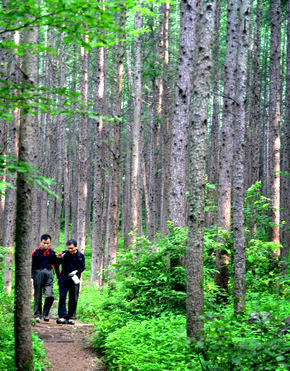 |
|
A forest
|
Soil acidity, health of trees surveyed
The overall health of Korean forests was found to be poor, with about half of the nation’s forested land consisting of trees more than 25 percent dead. This was one of the findings made by the Korea Forest Conservation Movement after a ‘Forest Health Monitoring’ study was conducted over the last two years on 356 designated areas in 46 major forest lands found in mountain ranges, cities, coastal areas, and on islands. The study, the first in its kind in Korea, attempted to determine the health of South Korean forests by monitoring a variety of indices, including plant growth and soil content. Korea’s forests were found to be in especially bad shape when looking at their so-called crown vitality, an indicator of health of the crowns of a forest’s trees, or their upper leaves and branches. The areas with a crown vitality of Class 1 (healthy), in which less than 10 percent of the leaves or branches are dead during the peak time of the forests turning green, barely passed half, at 51 percent. Those areas suffering light deterioration (11-25 percent dead), or Class 2 crown vitality, stood at 30 percent of the total. Those areas in which 26-50 percent of the trees’ crowns were dead, or Class 3, encompassed 10 percent of the studied areas. Classes 4 and 5, where more than half of the tree crowns in a forest were heavily deteriorated and/or dead, turned out to be a total of 9 percent of all areas. The study also found that the amount of Class 1 forests in urban areas (41 percent) was far lower than those in ordinary forests (60 percent) and forests found on islands (56 percent).Soil acidity, another indicator that shows the health of a forest, also posed concerns. Of the surveyed areas, 14 percent, including Mt. Sangdang in Cheongjoo, Mt. Moak in Jeonjoo, Mt. Inwang and Mt. Dobong in Seoul, Mt. Cheongryang in Incheon, Mt. Mudeung and Mt. Geumdang in Gwangju, Mt. Gaya in Gwangyang, and forests along the Han River in Seoul, were evaluated to be strongly acidic, with a pH rate at or below 4.5. The coniferous forest in Mt. Inwang was found to be the most acidic, with a 4.0 pH rate. The average of all surveyed areas was a 4.97 pH level. Experts say that 5.5 is the optimal pH rate for the growth of plants in Korea. Acidity renders the soil infertile by preventing it from storing nutrients. It also makes conditions difficult for trees to grow by reducing the number of microbes in the soil that help plants to absorb nutrients. Jo Hyeon-je, the head of the forest health monitoring team at the Korea Forest Conservation Movement, said that "the forests in cities are largely affected by air pollution and acid rain, for they are the forests that are highly deteriorated. We need to pay special attention to maintain the health of our forests." The research results will be presented at the International Symposium on Forest Health Monitoring, which will take place in Seoul on January 30. Please direct questions or comments to [englishhani@hani.co.kr]





